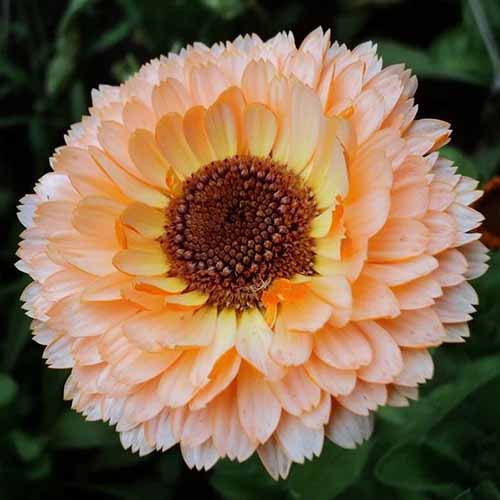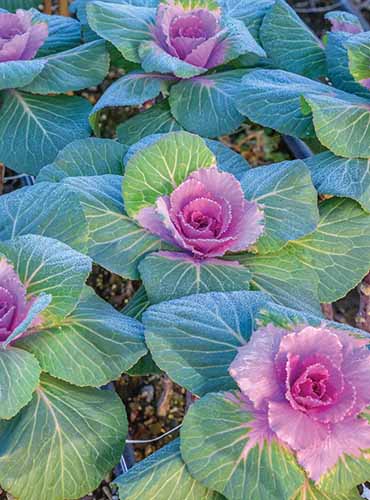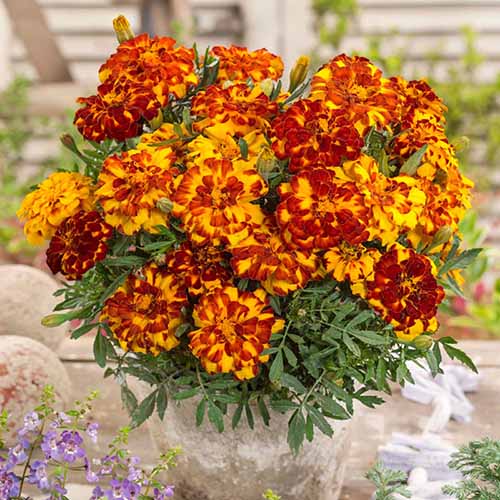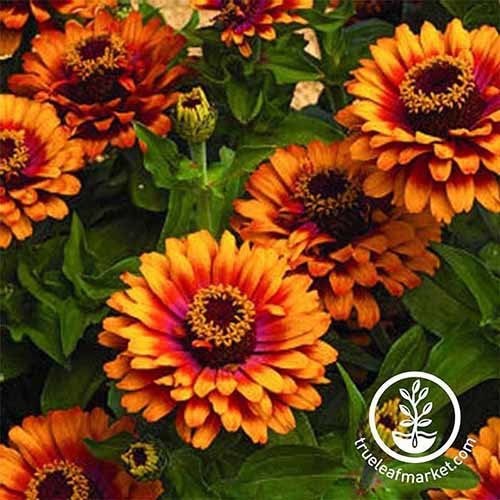The moderate and even sweltering temperatures in southern states gives us gardeners in the region an advantage in autumn.
For us, the riot of color from coleus, cleome, strawflower, and other summer annuals doesn’t have to stop when Labor Day rolls around.
Instead, we can turn to an attractive assortment of fall annuals for a color boost in our window boxes, hanging baskets, beds, borders, and landscapes.
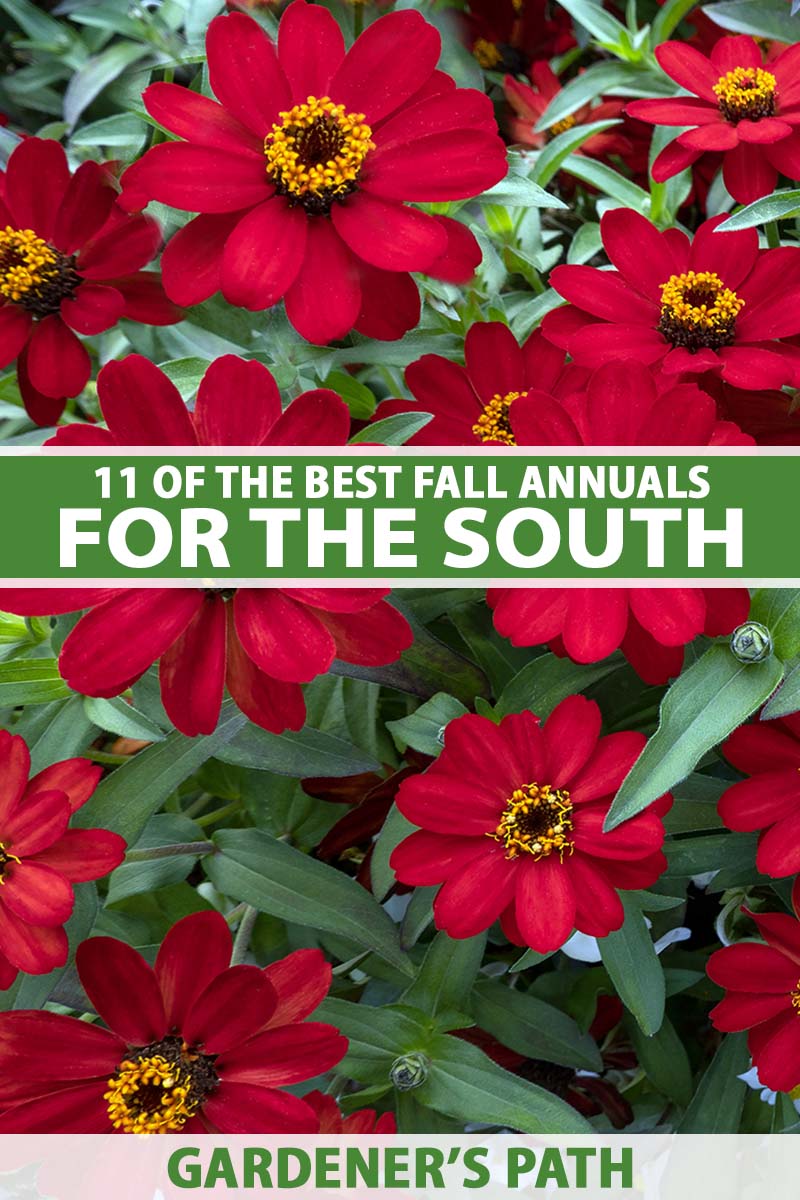
We link to vendors to help you find relevant products. If you buy from one of our links, we may earn a commission.
Of course, fall perennials like asters and mums are also appealing. But there’s something extra gratifying about sowing the annuals that will complete their growing cycle in a single year or season.
You can sow or transplant these cheery plants in July or August, enjoy the autumn show, and then toss the spent plants at season’s end without a care.
If this sounds appealing, we’ll make it easy to choose a fall annual suited to your area of the south that also suits your taste.
We’ve compiled a list of 11 of the best options. They include cool-weather ornamentals, wildflowers, and annuals that start blooming in late spring and are still going strong right up until the first frost.
The USDA Hardiness Zones cover quite a range here in the southern states, and that will affect what you grow and when you sow or transplant it.
I’m in East Tennessee, Zone 7, for example. Our average minimum temperature can plummet well below freezing in the winter, and the fall annuals I grow ordinarily succumb to chilly temperatures by mid-October.
As you go further south, the Zone numbers go higher and so do the autumn temperatures.
Most of Louisiana, Texas, and Georgia are in Zone 8, with a minimum average temperature of just 15°F, so those areas gain a few extra weeks of the weather that’s hospitable for fall annuals.
As a rule of thumb, in Zones 7 and 8 you can sow a new round of most flowering annuals in mid- to late July and still have time to enjoy a colorful show before too-cold temperatures set in and kill the tender annuals.
In Zones 9a to 10a you may be able to plant as late as Labor Day and still admire the colorful flowers or foliage up until November or even December.
The frost-free Zone 10b to 11 weather at the tip of Texas and in Florida makes it so folks there can grow a few of our choices as tender perennials instead – though that does take away the carefree enjoyment of growing annuals without a long-term commitment.
Ready to get into some specifics? Here are the plants that made the cut, along with a few tips on giving them the proper start for an optimal blooming season:
11 of the Best Fall Annuals for the South
When you’re a southern gardener, there are a few strategies that will make fall-grown annuals healthier and more likely to provide the color and blooms you’re striving for.

First, when you intend for flowering spring or early-summer planted annuals to keep blooming into fall, it’s generally best to consistently deadhead spent blossoms. This will encourage more blooms even as the weather gets cooler.
Also mulch and water summer annuals regularly, starting when you sow or transplant your chosen varieties.
Your aim is to keep the plants healthy enough to produce beautiful foliage or flowers for many months. Once a marigold or zinnia starts languishing in the hot-as-Hades weather, it will have a tough time making a comeback to bloom anew in autumn.
Some of the fall annuals on our list are drought- and heat-tolerant. But they will grow better with regular, deep watering whenever the ground is dry a couple of inches from the surface – especially if it hasn’t rained at least an inch in the previous week.
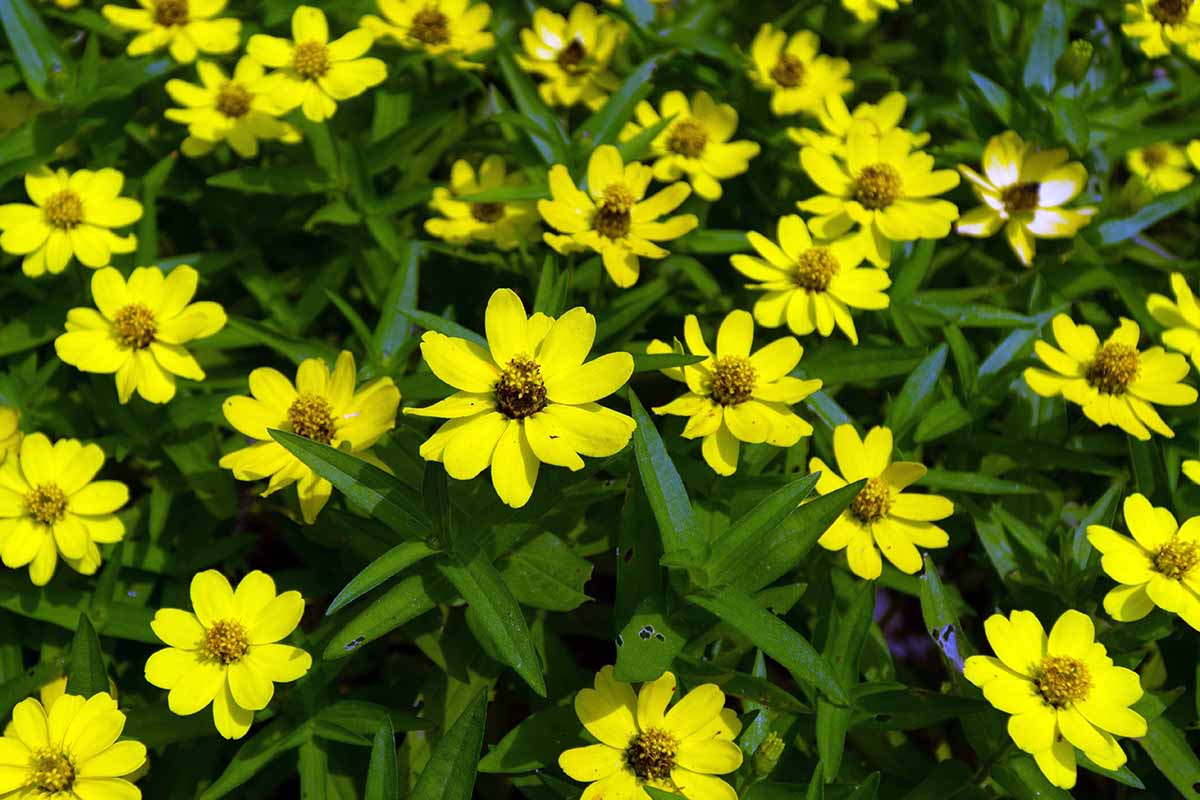
While many of the annuals on this list can be sown or transplanted in spring to continue blooming into autumn, others will require you to sow a new batch for fall color.
When you plant annuals any time after spring hoping they’ll mature in fall, it’s usually a good idea to sow the seeds indoors instead of direct seeding into the garden.
In the south, it’s too darn hot outside in July for newly germinated annual seedlings to survive without a lot of coddling, and it’s much easier to keep their growing mix moist indoors.
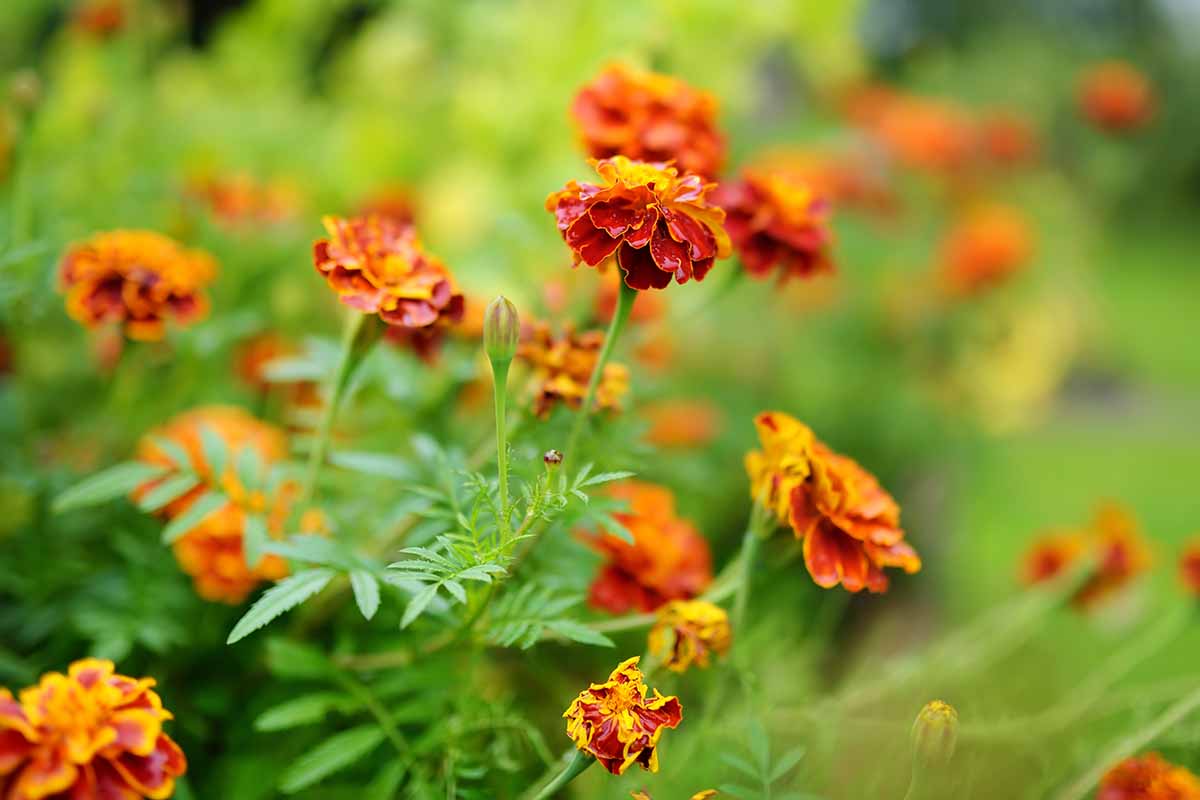
Most annual seeds should be sown four or five weeks ahead of transplanting into containers or garden beds. Harden the plants off for a week before transplanting into their outdoor growing space.
When you’re sowing in mid- to late summer in areas that experience frost, add at least a week to the number of “days to maturity” specified on your seed packet.
You’ll probably still have plenty of time for summer-sown annuals to mature and bloom ahead of the first frost, but it pays to double-check before investing time and energy.
Here are 11 of our top picks for colorful fall annuals to grow in the south:
1. China Aster
The rare annual aster, Callistephus chinensis, blooms in beautiful jewel tones from spring all the way up to the first frost.
Use it in containers, along walkways, or in garden beds. The colors are a treat, ranging from purples and pinks to white and yellow.
Giants of California is a hybrid series, featuring large, four- to five-inch double blooms in pink, purple, and white.
Giants of California China Aster
Find Giants of California mixed China aster seeds in packets or bulk at Eden Brothers.
Learn more about how to grow China asters in our guide.
2. Calendula
Low maintenance, with two- to three-inch, daisy-shaped flowers, calendula (Calendula spp.) can be grown as tender perennials in Zones 9 to 11, but these plants are annuals in Zones 7 to 8.
Calendula, also known as pot marigold, often self-seeds as well, returning the following year on its own.
The plants reach about 10 inches tall and spread a foot or more.
The ‘Pink Surprise’ cultivar complements the orange and russet tones so often found in autumnal floral arrangements.
The bushy plant will also attract beneficial insects when grown as a companion in the fall vegetable garden.
‘Pink Surprise’ calendula seeds are available in packets and bulk from Eden Brothers.
You can plant calendula in the spring in full sun and well-draining soil and expect it to bloom up until the first frost, particularly if you keep up with deadheading the flowers.
Note that it may languish in the summer heat, but will usually rebound to provide late summer and early autumn color.
It’s also possible to plant calendula in summer if you aren’t growing it already, but be sure to start seedlings indoors.
For more tips on growing calendula, see our guide.
3. Flowering Kale
Technically a biennial that takes two years to complete its life cycle and form seeds, flowering kale (Brassica oleracea), is usually grown as an annual.
Even though its roots could potentially survive a southern winter, the kale that emerges in the spring would be gangly, producing stalks of yellow flowers rather than the pink centers and round leaves of the first-year plants.
Flowering kale has become a favorite in fall flower arrangements, with sturdy stems that can last for a long time in a vase. The ornamental plants are also candidates for garden borders or window boxes, and may grow well into the winter.
‘Crane Pink’ looks like a round-leaf open cabbage with deep pink center leaves, and red and green veins on the exterior foliage.
Find ‘Crane Pink’ flowering kale available at Burpee. Choose from packets of 50 seeds or sets of 12 nursery starts.
This annual grows to 25 inches tall and requires full sun. Read more about growing ornamental kale here.
4. Fountain Grass
Ornamental grass is beautiful any time of year, but purple fountain grass, Pennisetum setaceum ‘Rubum,’ is particularly appealing, waving majestically in an autumn landscape or container.
In Zones 9 to 11, fountain grass grows as a perennial, but we southern gardeners in Zones 7 and 8 bid adieu to its deep purple leaves and flower spikes once temperatures plummet below 20°F.
Find purple fountain grass plants available in one-quart containers from Nature Hills Nursery.
You can grow purple fountain grass from divisions or purchased starts, but its seeds are sterile.
Transplant any time during the season and make sure to keep the young plants watered well for the first few months. Once they’re established, they’re drought tolerant.
In Zones 7 and 8, you’ll want to enjoy this annual before the first hard freeze destroys it, so consider transplanting as early in the spring as possible.
Learn more about growing purple fountain grass in our guide.
5. Marigold
Marigolds (Tagetes spp.) attract bees, butterflies, and hummingbirds while brightening a border or container with their bright blooms.
They are hardy enough to withstand heat, poor soil, and drought to bloom for months, starting in midsummer.
For fall color, make sure to regularly deadhead spent flowers throughout the season.
You can also grow new marigolds for autumn transplant by sowing the seeds indoors in July to plant out four to six weeks later.
‘Bolero’ is a French variety that grows 12 inches tall, and its orange and brick red bicolored double blooms scream out “fall is here!”
The petals of these flowers are edible when grown without pesticides, and the blooms also make a bright addition to autumn-themed cut flower arrangements.
Find packets and bulk quantities of ‘Bolero’ seed at Eden Brothers.
Learn more about how to grow marigolds in our guide.
6. Nasturtium
Nasturtium (Nasturtium spp.) is the quintessential annual for southern gardeners. You can sow the seeds in spring and enjoy the bright blooms throughout the summer.
The compact varieties are a delight in planters and borders, while the vining types can cascade over cottage garden walls or drape from hanging baskets.
When autumn rolls around, you may still be enjoying the edible flowers of nasturtiums sown in June. But you may also want to plant a new variety or two for fall containers or to cover bare spots left by fading summer annuals.
Be sure to plant in soil that drains well and ensure a full-sun location. Nasturtiums start blooming four to six weeks after sowing.
If you’re gardening in Zone 10 and above, you can sow the seeds in August or even September and enjoy the blooms into November or December. Those in Zones 7 to 9 should plan to start nasturtium seed by July at the latest.
Whirlybird Mix will make your heart sing with the semi-double blooms in a mix of autumn hues including maroon, yellow, cream, orange, peach, apricot, salmon, and scarlet.
Plants in this mix have a mounding habit and grow about 10 inches tall.
Find packets or bulk quantities of Whirlybird Mix available at True Leaf Market.
Read more about growing nasturtium flowers here.
7. Partridge Pea
Classified as legumes, partridge peas (Chamaecrista fasciculata) are wildflowers that grow about three feet tall and bear attractive yellow flowers with reddish-purple spots on their bases.
Also known as sensitive plant, the partridge pea’s leaves are comprised of narrow leaflets that close up if touched. The plant also exhibits nyctinasty, where the leaves close up at nightfall and reopen in the morning.
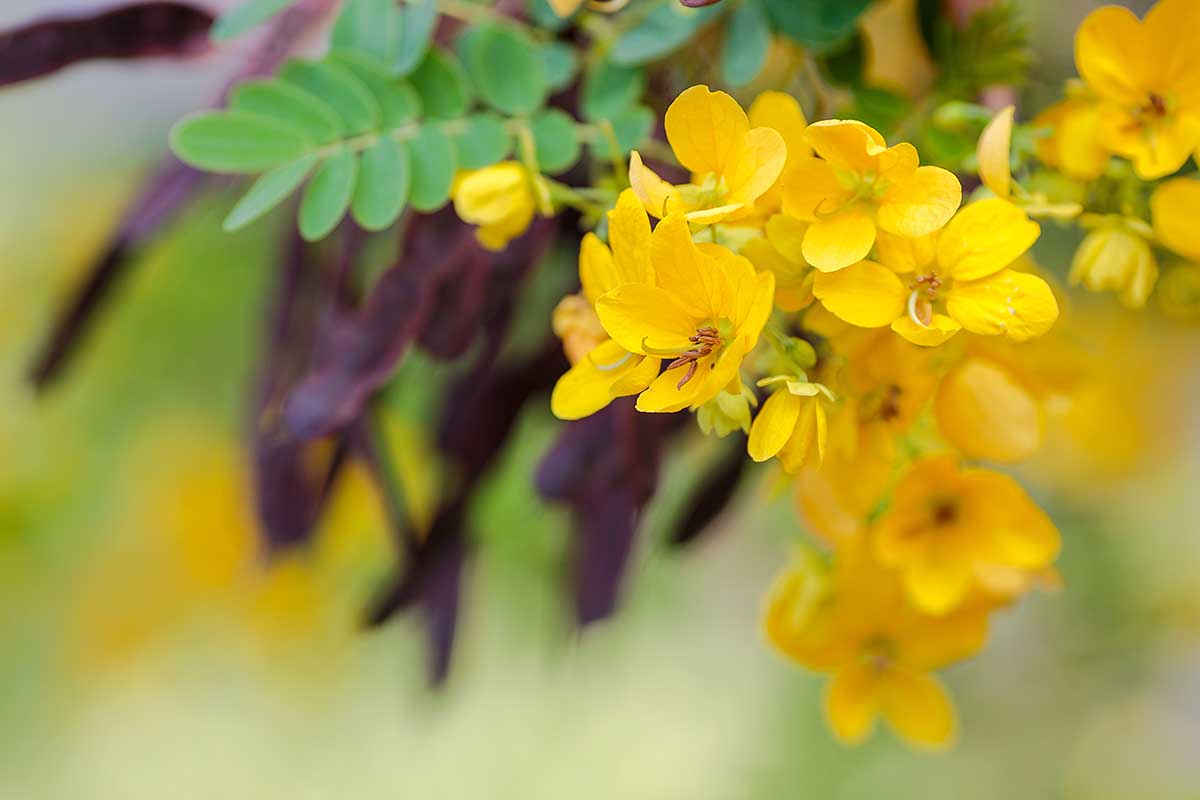
This annual is a host plant for several species of butterflies. It bears pea pods after the spent blooms fall, and the seeds contained in the pods attract birds. The pods are not edible.
Along with the colorful blooms that appeal to pollinators, partridge pea is one of the easiest fall-blooming annuals to grow and care for. It will thrive in average, sandy, or clay soil as long as it’s well-draining.
It needs moderate amounts of water, and can be planted in part shade though it prefers full sun.
Plant this pretty native in borders, along walkways, on inaccessible slopes, and in pollinator and meadow-type gardens.
Collect seeds from existing plants in late summer or fall. Seeds may be sown in fall, or frozen through the winter to sow in spring.

Find 200-seed packets of partridge peas available from David’s Garden via Amazon.
8. Petunia
Petunias (Petunia spp.) are so pretty. While some might associate them with Mother’s Day, they can also pep up early autumn window boxes, hanging baskets, beds, and borders, or you might like to plant them for blooming ground cover.
Southern gardeners in Zones 9 and above can treat petunias as tender perennials, but those of us in Zones 7 or 8 should grow these plants as annuals.
If you carefully tend petunias planted in spring, you can expect them to still bloom through the early weeks of autumn.
When you start growing petunias in summer expressly for fall color, note they’ll need 10 to 12 weeks after sowing to begin flowering.
Sow seeds indoors in late June. They take about a week to germinate and another four or five weeks to grow large enough to harden off and transplant into the garden.
Petunias won’t germinate at temperatures higher than 80°F, so there’s no point sowing them outdoors in a southern summer!
When you’re lucky enough to find starts or even full-grown plants at your local nursery in late summer, snap them up!
If you plant them in a full sun location with fertile, well-draining soil and keep them watered and deadheaded, they should keep blooming through early autumn and maybe up until the first frost.
Supercascade is a series of grandiflora petunias, with large flowers in vibrant colors and an upright, mounded growth habit.
Find seeds for Supercascade petunias available at True Leaf Market in blue, burgundy, pink, red, rose, white, and as a mix.
Read more about growing petunias here.
9. Snow Pea
Maybe not the first fall annual to come to mind for southern growers, especially with “snow” as part of their name, snow peas (Pisum sativum) are nonetheless a fine selection to plant in late summer for pretty, pink and purple, edible blooms on three-foot plants.
The clover-shaped, green foliage is also attractive, and the plants complement other fall annuals like jewel-tone China asters in hanging baskets, raised beds, or autumn-themed window boxes.
These legumes are not one of the autumn-blooming annuals you can sow or transplant in the midsummer heat. Once they’ve germinated, they only grow, flower, and perhaps produce pods when the temperature stays below 85°F, and they do best in the 55 to 65°F range.
‘Dwarf Grey’ is a compact variety that tops out at about three feet tall, and in addition to the attractive flowers, you’ll have a harvest of edible pea pods to look forward to!
‘Dwarf Grey’ seeds in 100, 400, and 1,600-count packages are available from Eden Brothers.
Most commonly grown as a food crop, fall-planted ‘Dwarf Grey’ can do triple duty as an ornamental, a source of edible blooms and pods, and an attractive cover crop for a spring vegetable garden.
Learn more in our guide to growing snow peas.
10. Sunflower
Sunflowers (Helianthus annuus) herald summer, but certain varieties can also brighten the early days of autumn.
‘Autumn Beauty’ is a colorful variety, living up to its name as a fall annual, producing a riot of copper, yellow, rust, and bicolor blooms on bushy plants that reach four to eight feet tall.
Find ‘Autumn Beauty’ mix seeds in packets and bulk sizes at Eden Brothers.
Pollinators will be drawn to the nectar-rich blooms and you can also save the seeds to plant next year.
Sunflowers generally take 75 to 90 days from sowing to bloom, so be sure to sow the seeds with enough time to flower before the first killing frost in your area.
In Zones 9 and above it’s possible to plant sunflowers any time of year.
Learn more about how to grow sunflowers in our guide.
11. Zinnia
Zounds! All zinnias (Zinnia spp.) have a colorful appeal blooming in an autumn-theme planter or in a long-stemmed arrangement, but ‘Zowie Yellow Flame’ is particularly eye-catching.
The flowers have large red central cones circled by several layers of magenta pink petals, with yellow tips that gradually change to a deep red.
The blooms are as big as teacups – three to five inches across, With their sturdy, three-foot-tall stems and brilliant colors, they brighten beds and borders and are also great as cut flowers.
Starting seeds indoors to transplant out is recommended, particularly if you’re looking for fall blooms. This variety takes 75 to 85 days from sowing to bloom, so it needs that head start.
Find 10- or 100-seed packets of ‘Zowie Yellow Flame’ available at True Leaf Market.
This is one of the most reliable “cut and come again” annuals you can grow.
Expect flowering 75 days after sowing seed. Pinching the first set of buds helps this majestic zinnia branch, and harvesting flowers for vases and deadheading spent blooms will encourage ongoing production.
Like all zinnias, ‘Zowie Yellow Flame’ needs full sun, proper air circulation, and soil-surface watering to prevent its most common ailment, powdery mildew.
Read more about growing zinnias here.
Falling in Love with Autumn’s Annuals
Any of these selections can quickly grow from seed – or nursery start – to provide a colorful show in your garden or a container this autumn.

Speedy growth is part of the appeal of growing annuals. You plant, they grow, they’re lovely, then they’re done, and you start over again the next year or next season.
Do you know any fall annual favorites that grow well in the south that we haven’t covered here? Be sure to share your experience and questions in the comments section below.
And if this roundup struck your fancy, check out these guides for more flower gardening tips:

